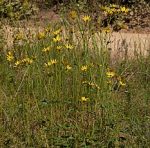 Native to woodland edges of southcentral US, this little known herbaceous perennial is also called as rosinweed sunflower. It is a member of the aster family, Asteraceae, that also includes daisy, yarrow, and lettuce. Plants have a fibrous root system with short rhizomes and central sparingly branched stems that are 3-10′ tall, hispid below, and may be light green, light yellow, or light brown. The oval to ovate leaves are mostly at the bottom of the stems and are up to 6″ long. They tend to be medium green to yellow green above, have finely toothed margins, and are sparsely covered with small stiff hairs. Leaves on the upper parts of the stem are conspicuously smaller in size. For 3-4 weeks beginning in late summer, flowerheads appear either singly or in small loose clusters of 2-3. Each flowerhead is 2-3″ wide and consists of 8-20 bright yellow ray flowers surrounding a central disc of 75 or more red disc flowers. The flowerheads are attractive to butterflies and bees and the seedheads are attractive to birds. Ozark sunflower is valued for its abundance of flowers and its relatively non-aggressive manner which make it a desirable choice for wildflower, native plant, butterfly, wildlife and cottage gardens. The genus name, Helianthus, comes from the Greek words helios, meaning sun, and anthos meaning flower and may refer to the resemblance of the flowerhead to the sun. The specific epithet, silphioides, refers to the resemblance of Ozark sunflower to plants in the genus Silphium, also tall perennials in the aster family.
Native to woodland edges of southcentral US, this little known herbaceous perennial is also called as rosinweed sunflower. It is a member of the aster family, Asteraceae, that also includes daisy, yarrow, and lettuce. Plants have a fibrous root system with short rhizomes and central sparingly branched stems that are 3-10′ tall, hispid below, and may be light green, light yellow, or light brown. The oval to ovate leaves are mostly at the bottom of the stems and are up to 6″ long. They tend to be medium green to yellow green above, have finely toothed margins, and are sparsely covered with small stiff hairs. Leaves on the upper parts of the stem are conspicuously smaller in size. For 3-4 weeks beginning in late summer, flowerheads appear either singly or in small loose clusters of 2-3. Each flowerhead is 2-3″ wide and consists of 8-20 bright yellow ray flowers surrounding a central disc of 75 or more red disc flowers. The flowerheads are attractive to butterflies and bees and the seedheads are attractive to birds. Ozark sunflower is valued for its abundance of flowers and its relatively non-aggressive manner which make it a desirable choice for wildflower, native plant, butterfly, wildlife and cottage gardens. The genus name, Helianthus, comes from the Greek words helios, meaning sun, and anthos meaning flower and may refer to the resemblance of the flowerhead to the sun. The specific epithet, silphioides, refers to the resemblance of Ozark sunflower to plants in the genus Silphium, also tall perennials in the aster family.
Type: Herbaceous perennial
Bloom: Flowerheads with bright yellow ray flowers surrounding a center of red disc flowers in late summer into fall
Size: 3-10′ H 1-5′ W
Light:Full sun to partial sun
Soil: Average, medium moist to dry, well-drained
Hardiness: Zones 5-9
Care: May need staking
Pests and Diseases: Downy mildew
Propagation: Seed, division
Companion Plants: Asters, goldenrod, slender bush clover
Photo Credit: Wikipedia